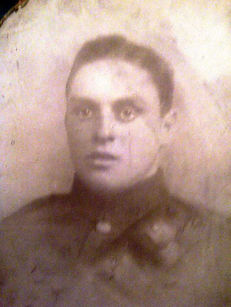RFA West Lancs Bdes
681502 DVR. T. J. MOORCROFT. R.F.A.
Thomas James Moorcroft was born on 15 November 1895 in Walton, Liverpool. His father was Thomas Moorcroft (b. 1856 in Walton), a canal porter. His mother was Esther Ellen Price (b. 1857 in Liverpool). Thomas and Esther were married in 1878 and they had 14 children, though 4 died in infancy. The survivors were: Charles (b. 1879), Elizabeth (b. 1881), Mary (b. 1883), Ada (b. 1885), Margaret (b. 1887), Sarah (b. 1888), Esther (b. 1891), Emily (b. 1893), then Thomas, and finally William Edward (b. 1898). In 1911, Thomas and Esther were living with 3 of their children at 15 Breeze Lane, Walton. Tom jnr was working as a butcher’s errand boy. Tom must have enlisted in 1915 or early 1916, and his mother died at the end of 1916 and his father died in early 1917.
Tom enlisted with the Royal Field Artillery and was assigned service number 681502 and posted to “D” Battery of 286 Brigade.

After training, the Brigades left for France in early 1917 and were involved in the heavy fighting to defend the town of Armentières, on the French-Belgian border. In July 1917 they suffered their first attack by the new mustard gas. In late September the Brigade was relieved from the front line and withdrew for a period of training, and returned to the line at Langemark about 35km north of Armentières, not far from the small village of Passchendaele, which would be the scene of some of the bloodiest battles of the War. On 9 October 286 Brigade returned to action engaging in harassing and destructive fire on enemy strongpoints, but also suffering their heaviest losses of the war so far, with many soldiers being gassed. On 27 October, 285 and 286 Brigades were placed under temporary command of the Canadians as they began the final attack on the village of Passchendaele. From 1-7 November, 286 Brigade were at Langemark engaged in the defence of the village and were under heavy shelling from the enemy, including gas attacks every day.
In early December 1917 the Brigade was in training at Polincove in north-east France. They returned to Haandekot in Belgium on 7 December and two days later took up their position in the line in the Steenbeck Valley, north-west of Ypres. The War Diary records that they “engaged in usual harassing fire on enemy’s tracks, roads etc.”
On 1 January 1918, the Division began preparations to return to Armentières. On 5 January, batteries took up their positions at Erquinghem, about 3kms west of the town. At the start of the year, brigade numbers were: 29 Officers, 795 Other Ranks and 656 horses.
It was close to Armentières, on 6 February 1918, that Tom was killed in action. The War Diary records some shelling that day, including over 100 rounds of gas shells and 330 rounds of 15cm shells but does not record any specific deaths. Tom was 22 years old.
Rank: Driver
Service No: 681502
Date of Death: 06/02/1918
Regiment/Service: Royal Field Artillery, “D” Bty, 286th Bde.
Grave Reference: II. D. 46.
Cemetery: CITE BONJEAN MILITARY CEMETERY, ARMENTIERES
Tom’s brother, William Edward, also served and died in the War. He was 107371 PTE. W. E. MOORCROFT. M.G.C. (I). He was born on 29 August 1898. He turned 18 in 1916 and he first enlisted with 6Bn North Somerset Yeomanry, with service number 274, but later was transferred to the Machine Gun Corps (Infantry) and posted to 9th Battalion. He was killed in action on 29 September 1918. He was 20 years old.
In March 1918, the Machine Gun Companies in each Division were amalgamated into Battalions. 9th Battalion was composed from 26th, 27th and 28th Machine Gun Companies, in 9th (Scottish) Division. In 1918, 9th Division was engaged in both phases of the German Spring Offensive – during the First Battle of the Somme 1918 at the Battle of St Quentin and the First Battle of Bapaume; and during the Battle of the Lys at Messines, Bailleul and the Battles of Kemmel. They were in action again when the advance in Flanders began and were involved in the capture of Outtersteene Ridge (August 1918). They were then engaged in the final push from Ypres towards Courtrai which began on 28 September and William was killed in action the following day. His body was not recovered.
Rank: Private
Service No: 107371
Date of Death: 29/09/1918
Regiment/Service: Machine Gun Corps (Infantry), 9th Bn.
Memorial Reference: Panel 154 to 159.
Memorial: TYNE COT MEMORIAL
